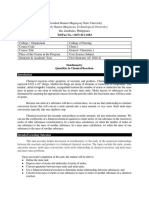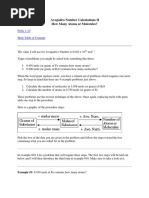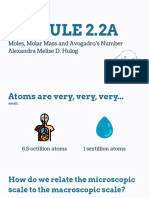1 2 The Mole and Molar Mass
1 2 The Mole and Molar Mass
Uploaded by
api-327781490Copyright:
Available Formats
1 2 The Mole and Molar Mass
1 2 The Mole and Molar Mass
Uploaded by
api-327781490Original Title
Copyright
Available Formats
Share this document
Did you find this document useful?
Is this content inappropriate?
Copyright:
Available Formats
1 2 The Mole and Molar Mass
1 2 The Mole and Molar Mass
Uploaded by
api-327781490Copyright:
Available Formats
The Mole & Molar Mass
The mole is the standard method in chemistry for communicating how much of a
substance is present.
Here is how the International Union of Pure and Applied Chemistry (IUPAC) defines
"mole:"
The mole is the amount of substance of a system which contains as many elementary
entities as there are atoms in 0.012 kilogram of carbon-12. When the mole is used, the
elementary entities must be specified and may be atoms, molecules, ions, electrons,
other particles, or specified groups of such particles.
This is the fundamental definition of what one mole is. One mole contains as many
entities as there are in 12 grams of carbon-12 (or 0.012 kilogram).
In one mole, there are 6.022 x 1023 atoms. Here's another way: there are 6.022 x
1023 atoms of carbon in 12 grams of carbon-12.
Let's say that real clearly: one mole of ANYTHING contains 6.022 x 10 23 entities.
The word "entities" is simply a generic word. For example, if we were discussing
atoms, then we would use "atoms" and if molecules were the subject of discussion, the
word entities would be replaced in actual use by "molecules."
Avogadro's Number has been very carefully measured in a number of ways over many
decades. The symbol for mole is "mol." Why does a four-letter word have a threeletter symbol? That's really the wrong question.
Here it is again: one mole of ANY specified entity contains 6.022 x 10 23 of that entity.
For example:
One mole of donuts contains 6.022 x 1023 donuts
One mole of H2O contains 6.022 x 1023 molecules
One mole of nails contains 6.022 x 1023 nails
One mole of Fe contains 6.022 x 1023 atoms
One mole of dogs contains 6.022 x 1023 dogs
One mole of electrons contains 6.022 x 1023 electrons
One mole of IB Chemistry students contains 6.022 x 10 23 poor, suffering (I
mean happy, joyful) high school students
Get the idea?
6.022 x 1023 is so important in chemistry that it has a name. It is called Avogadro's
Number and has the symbol N. It is so named in honor of Amedeo Avogadro, an
Italian chemist, who, in 1811, made a critical contribution (recognized only in 1860
after his death) which helped greatly with the measurement of atomic weights.
Avogadro's Number has a unit associated with it. It is mol 1, as in 6.022 x 1023 mol1.
The superscripted minus one means the unit mol is in the denominator. There is an
understood numerator of one, as in 1/mol.
Why is there no unit in the numerator? There could be, but it would vary based on the
entity involved. If we were discussing an element, we might write atoms/mol. If we
were discussing a compound, we would say "molecules per mol." What is in the
numerator depends on what "entity" (atom, molecule, ion, electron, etc.) is being used
in the problem.
Consequently, units names in the numerator are not used and a one is used instead.
Getting back to Avogadro's Number role in chemistry; please note that counting atoms
or molecules is very difficult since they are so small. However, we can "count" atoms
or molecules by weighing large amounts of them on a balance.
When we weigh one mole of a substance on a balance, this is called a "molar mass"
and has the units g/mol (grams per mole). This idea is very critical because it is used
all the time.
A molar mass is the weight in grams of one mole.
One mole contains 6.022 x 1023 entities.
Therefore, a molar mass is the mass in grams of 6.022 x 10 23 entities.
OK. How does one calculate a molar mass? Get ready, because you already know how
to calculate a molar mass.
The molar mass of a substance is the molecular weight in grams.
All you need to do is calculate the molecular weight and stick the unit "g/mol" after
the number and that is the molar mass for the substance in question.
Calculate the molar mass of Al(NO3)3
(1 x 26.98) + (3 x 14.007) + (9 x 16.00) = 213.00 g/mol
213.00 grams is the mass of one mole of aluminum nitrate.
213.00 grams of aluminum nitrate contains 6.022 x 10 23 entities of Al(NO3)3
You might also like
- Service Manual Komatsu WH609-1, WH613-1, WH713-1, WH714-1, WH714H-1, WH716-1 (Preview)Document6 pagesService Manual Komatsu WH609-1, WH613-1, WH713-1, WH714-1, WH714H-1, WH716-1 (Preview)Amip FolkNo ratings yet
- Napoleon Lynx CDJ ManualDocument29 pagesNapoleon Lynx CDJ Manualn8rld4879No ratings yet
- Electronic Unit Injector - Install: C6.6 Industrial EngineDocument13 pagesElectronic Unit Injector - Install: C6.6 Industrial EngineBassieNo ratings yet
- The Basics of SpectrosDocument133 pagesThe Basics of SpectrosMidabel100% (7)
- Molar MassDocument9 pagesMolar MassJasper Caande Quimbo0% (1)
- Mole Concept: Grade 9Document12 pagesMole Concept: Grade 9Rosalyn RayosNo ratings yet
- Molar Mass: Avogadro's Number and The MoleDocument5 pagesMolar Mass: Avogadro's Number and The MoleMegan CabahugNo ratings yet
- General Chemistry 1: Learning Activity SheetsDocument11 pagesGeneral Chemistry 1: Learning Activity SheetsJeffrey Uy EscotoNo ratings yet
- Chem 1A Unit 0 Module 9Document17 pagesChem 1A Unit 0 Module 9Wade DachNo ratings yet
- Converting Between Moles and AtomsDocument7 pagesConverting Between Moles and Atomsshirley cortezNo ratings yet
- LM - Stoichiometry Part 1 PDFDocument16 pagesLM - Stoichiometry Part 1 PDFikennahtNo ratings yet
- The MoleDocument1 pageThe MoleLinden EvangelistaNo ratings yet
- W13 Module - StoichiometryDocument16 pagesW13 Module - StoichiometryArmin ArleltNo ratings yet
- Atoms Molecules and IonsDocument78 pagesAtoms Molecules and IonszulqarnainkhaliqNo ratings yet
- The MoleDocument4 pagesThe MolePirated VirusNo ratings yet
- The Mole IntroductionDocument15 pagesThe Mole IntroductionJov Vito Jr.No ratings yet
- 4) Chemical ReactionsDocument13 pages4) Chemical ReactionsEricka Jane Roga PalenciaNo ratings yet
- Chemistry NotesDocument11 pagesChemistry NotesFaik SafaraliNo ratings yet
- Avogadro's NumberDocument5 pagesAvogadro's NumberM J RhoadesNo ratings yet
- The MoleDocument7 pagesThe Moleapi-256236481No ratings yet
- Use Mole Concept To Express Mass of SubstancesDocument11 pagesUse Mole Concept To Express Mass of SubstancesGiamarie Nieto Aclao MangubatNo ratings yet
- Stoichiometry Definitions and ExamplesDocument6 pagesStoichiometry Definitions and Examplesbuhlemtsweni01No ratings yet
- III. Mass - Relationships - and - Chemical - ReactionsDocument13 pagesIII. Mass - Relationships - and - Chemical - ReactionsHania ABDULNo ratings yet
- A MoleDocument2 pagesA MoleAkash ChopraNo ratings yet
- Avogadro Number Calculations IIDocument7 pagesAvogadro Number Calculations IIKrizza Joy Lintag CaspeNo ratings yet
- Activity 1.3: Activity: Familiarizing With Avogadro's ConstantDocument5 pagesActivity 1.3: Activity: Familiarizing With Avogadro's ConstantAli RazaNo ratings yet
- Worksheet Amount of Substance and The MoleDocument14 pagesWorksheet Amount of Substance and The MoledookystevensNo ratings yet
- Moles and Molar MassDocument6 pagesMoles and Molar MassNancy MohamedNo ratings yet
- IB Chemistry Notes - Stoichiometry and The Mole ConceptDocument1 pageIB Chemistry Notes - Stoichiometry and The Mole ConceptKefin TajebNo ratings yet
- Applied Chemistry Week 4Document16 pagesApplied Chemistry Week 4aleonora500No ratings yet
- Ảnh Màn Hình 2023-07-14 Lúc 23.03.00Document1 pageẢnh Màn Hình 2023-07-14 Lúc 23.03.00Tâm Lê Nguyễn KhánhNo ratings yet
- The Mole & Molar MassDocument26 pagesThe Mole & Molar MassAbdulhamid Abdulwaasi100% (2)
- The Mole ConceptDocument59 pagesThe Mole ConceptDelano PeteNo ratings yet
- 4Document2 pages4shreyanshusbeheraNo ratings yet
- Chemistry 11Document39 pagesChemistry 11Chhavindra TripathiNo ratings yet
- CUP IBChemistry c01 It MolesDocument53 pagesCUP IBChemistry c01 It MolesAdnan ChowdhuryNo ratings yet
- MoleDocument12 pagesMoleapi-315888246No ratings yet
- The Mole and AvogadroDocument3 pagesThe Mole and AvogadrokarimNo ratings yet
- Mole and Molar Mass of Elements and Compounds - ReportDocument12 pagesMole and Molar Mass of Elements and Compounds - ReportIngrid Kim100% (2)
- Uploads3723372339971.1 Moles and Molar Mass Student PDFDocument2 pagesUploads3723372339971.1 Moles and Molar Mass Student PDFblummadison22No ratings yet
- 9th Mole Concept and Problems Based On PDFDocument2 pages9th Mole Concept and Problems Based On PDFMintu KhanNo ratings yet
- 9th Mole Concept and Problems Based On PDFDocument2 pages9th Mole Concept and Problems Based On PDFMintu KhanNo ratings yet
- 1. Mole Concept BDocument1 page1. Mole Concept BNkemzi EliasNo ratings yet
- Amount of SubstanceDocument15 pagesAmount of SubstanceddddddffdfdfNo ratings yet
- Chem10 - Week5 Mole ConceptDocument35 pagesChem10 - Week5 Mole ConceptVanessa Angela CruzNo ratings yet
- 20121014071018HBSC 4303 5Document19 pages20121014071018HBSC 4303 5رزالي زكريNo ratings yet
- Mole ConceptDocument21 pagesMole Conceptdipanshuporas4No ratings yet
- LAS6 - Lingling, Genesis Casino, Joekim Gutiurrez, Gene DominicDocument6 pagesLAS6 - Lingling, Genesis Casino, Joekim Gutiurrez, Gene DominicNelson MongpongNo ratings yet
- 3. IQ2 How Are Measurements Made in Chemistry -Mole Concept (1)Document13 pages3. IQ2 How Are Measurements Made in Chemistry -Mole Concept (1)bennoonan6464No ratings yet
- L.O.10chemistry G 10Document33 pagesL.O.10chemistry G 10bebo atefNo ratings yet
- The Mole ConceptDocument3 pagesThe Mole ConceptRajiv SharmaNo ratings yet
- Lc4 Stoich p1 Ay22-23Document6 pagesLc4 Stoich p1 Ay22-23Nikki nishimuraNo ratings yet
- Mole ConceptDocument3 pagesMole Conceptranaabdullahafzaal862250No ratings yet
- Lesson 3. The Mole Concept and The Molar Mass of ElementsDocument4 pagesLesson 3. The Mole Concept and The Molar Mass of ElementsJamelle SilvestreNo ratings yet
- 3 Atoms And MoleculesDocument38 pages3 Atoms And Moleculessodhisohan57No ratings yet
- Module 2.2A: Moles, Molar Mass and Avogadro's Number Alexandra Melise D. HulogDocument17 pagesModule 2.2A: Moles, Molar Mass and Avogadro's Number Alexandra Melise D. HulogDarnell SimmonsNo ratings yet
- Pre Reporte QuimicaDocument9 pagesPre Reporte QuimicaIsabel Sofia Corredor MendezNo ratings yet
- Concepts of Nuclear Medicine Volume I: Concepts of Nuclear Medicine, #1From EverandConcepts of Nuclear Medicine Volume I: Concepts of Nuclear Medicine, #1No ratings yet
- Chemistry for Students: The Only Chemistry Study Guide You'll Ever Need to Ace Your CourseFrom EverandChemistry for Students: The Only Chemistry Study Guide You'll Ever Need to Ace Your CourseNo ratings yet
- ReadmeDocument5 pagesReadmeLukas Eska E CNo ratings yet
- Modified SF QuizDocument9 pagesModified SF QuizgeekyboygeekyboyNo ratings yet
- DSQC256ADocument510 pagesDSQC256AAnonymous smdEgZN2IeNo ratings yet
- Which of The Following Is An Example of An Inelastic Impression Material?Document28 pagesWhich of The Following Is An Example of An Inelastic Impression Material?Abo QadeerNo ratings yet
- Aluminum Mill Products: Aluminum Angle, Channel, Pipe Fittings, Pipe, Rod, Bar, Sheet, Plate, Coil & TubingDocument44 pagesAluminum Mill Products: Aluminum Angle, Channel, Pipe Fittings, Pipe, Rod, Bar, Sheet, Plate, Coil & TubingVANo ratings yet
- Whittaker Bradley Resume 112315Document2 pagesWhittaker Bradley Resume 112315api-302466463No ratings yet
- ASMEHeaterForm004783 004788Document2 pagesASMEHeaterForm004783 004788arissaNo ratings yet
- 15BMD0020 - 1Document14 pages15BMD0020 - 1Broklen Hawk Jr.No ratings yet
- 6 Track JunctionsDocument18 pages6 Track Junctionsarpit089No ratings yet
- TC BCWR Schools List Tgcet - TeachersBADI - inDocument14 pagesTC BCWR Schools List Tgcet - TeachersBADI - inTaranath0% (1)
- Altec Lansing 1594-B Owners ManualDocument14 pagesAltec Lansing 1594-B Owners Manualspiders34No ratings yet
- Installation Guide For 20/20: Profile Ridge, Rollridge, Roll Hip, Profile Mono Ridge and 20/20 Verge InstallationDocument6 pagesInstallation Guide For 20/20: Profile Ridge, Rollridge, Roll Hip, Profile Mono Ridge and 20/20 Verge Installationslindelft-cool7056No ratings yet
- Acer TabletDocument88 pagesAcer TabletLacey Elizabeth NavinNo ratings yet
- Dye Penetrant Procedure DP BsDocument6 pagesDye Penetrant Procedure DP Bs1339979No ratings yet
- MANUAL ENGRASE AUTOMATICO 85728-85729-85730 Conjunto Flow Master II 24volt 60lbs, 90lbs y 120lbs Serie B 404567D Version 3 (3898)Document80 pagesMANUAL ENGRASE AUTOMATICO 85728-85729-85730 Conjunto Flow Master II 24volt 60lbs, 90lbs y 120lbs Serie B 404567D Version 3 (3898)nacho ortizNo ratings yet
- Astm A194Document3 pagesAstm A194luizz100% (1)
- DSP Viva Questions PDFDocument4 pagesDSP Viva Questions PDFMallikharjuna GoruNo ratings yet
- ZM4000+Mxp 010+BMS+InterfaceDocument5 pagesZM4000+Mxp 010+BMS+InterfaceabdurasheediNo ratings yet
- Power Management PDFDocument6 pagesPower Management PDFandersonpauserNo ratings yet
- CEH v5 Exam Study GuideDocument97 pagesCEH v5 Exam Study GuidelicservernoidaNo ratings yet
- Sinovoltaics Inverter Manufacturer Ranking Report Edition 2 2024Document16 pagesSinovoltaics Inverter Manufacturer Ranking Report Edition 2 2024Lucas LeoniNo ratings yet
- Kingair 350i Wiring - 21 Air ConditionedDocument68 pagesKingair 350i Wiring - 21 Air ConditionedLaboratorio01 AvionicsNo ratings yet
- Belt-Coupled Motor Generator SetDocument173 pagesBelt-Coupled Motor Generator Setcustro_mohaleNo ratings yet
- Nord KockDocument12 pagesNord KockMarcoNo ratings yet
- Magmatic DifferentiationDocument6 pagesMagmatic DifferentiationEbenezerSherlockAyiteyNo ratings yet
























































































